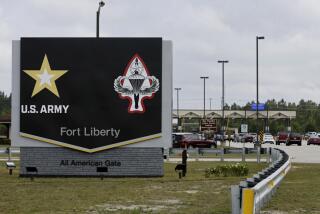Point Mugu Ceremony Marks Merger of Labs
- Share via
With a whistling bosun’s pipe and a thunderous cannon salute, U.S. Navy personnel renamed the Point Mugu Naval Air Station on Tuesday and designated it the headquarters for the cost-cutting merger of four naval weapons labs.
The 46-year-old station was renamed the Point Mugu Naval Air Weapons Station with a change of flags and commanders, who then proclaimed it headquarters of the new Naval Air Warfare Center (NAWC) Weapons Division.
The full-dress ceremony symbolized work already under way to streamline weapons development at Point Mugu, China Lake, Albuquerque, N.M., and White Sands, N.M., combining the labs into one huge test facility.
Under the merger, command of the labs and contracting procedures will be simplified, and personnel will be reduced by 20% through attrition.
The change is expected to save taxpayers $115 million by 1995.
The four labs must undergo “a mind-set change,” said Adm. George H. Strohsahl Jr., who oversees the new NAWC Weapons Division and the Aircraft Division, a group of East Coast aircraft test sites based in Patuxent, Md.
Strohsahl said the weapons labs must stop duplicating each other’s work and coordinate as efficiently as possible to maintain and improve the Navy’s arsenal.
“With the shrinking defense budget and the downsizing that must occur, we certainly have our work cut out for us,” Strohsahl told the audience of sailors, airmen, Marine avionics experts and lab officials from all four sites.
A trumpeter called the military personnel to attention so Strohsahl could read the U.S. Defense Department order, effective Jan. 2, that merged the West Coast weapons labs and East Coast aircraft labs into the Naval Air Warfare Center.
Then, accompanied by a soft drum roll, Adm. William E. Newman read the order to replace the flag of the independent Pacific Missile Test Center at Point Mugu with the flag of the unified NAWC Weapons Division command.
As the military personnel saluted, a two-man color guard marched out with both flags.
Slowly one airman furled the old eagle-and-anchor flag, then the other loosed the new flag so its NAWC logo and missile-firing jet fighter could flap in the sun.
Newman then read the Defense Department’s order placing him in command of the NAWC Weapons Division.
“The die is cast,” Newman said. “We are different now, and we will continue to evolve over the next few years. . . . We are more than just a few changed signs on gates and buildings around a station.”
Newman also called for an end to wasteful competition between the labs, which often put missiles such as Sparrow and Tomahawk through identical testing at China Lake and Point Mugu.
Newman said now that “the other guys lost the Cold War” and the Soviet Union disintegrated, the U.S. Navy labs must “figure out what we need.”
“We must run this 11,000-person organization as a business enterprise, now more than ever before,” he said.
“Duplication must and will be replaced with better efficiency, by making sure our work can be done better, faster and cheaper.”
More to Read
Sign up for Essential California
The most important California stories and recommendations in your inbox every morning.
You may occasionally receive promotional content from the Los Angeles Times.













